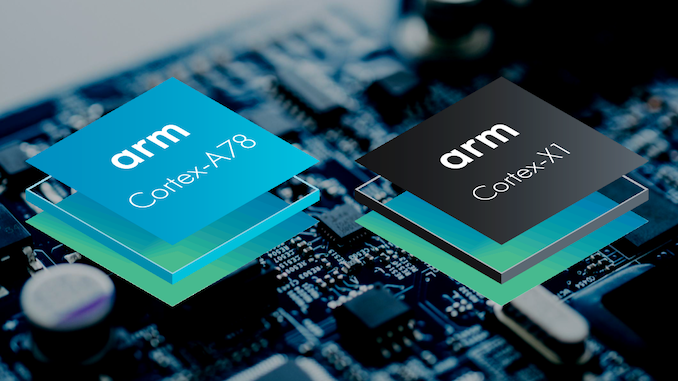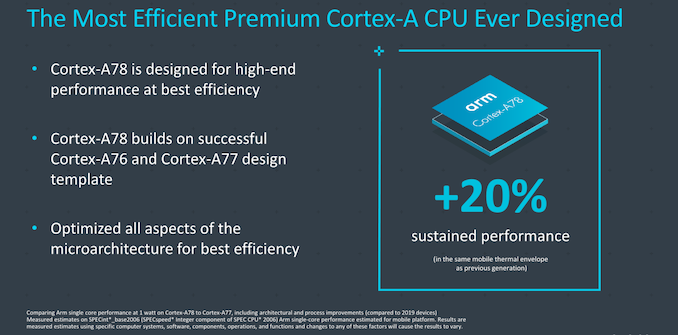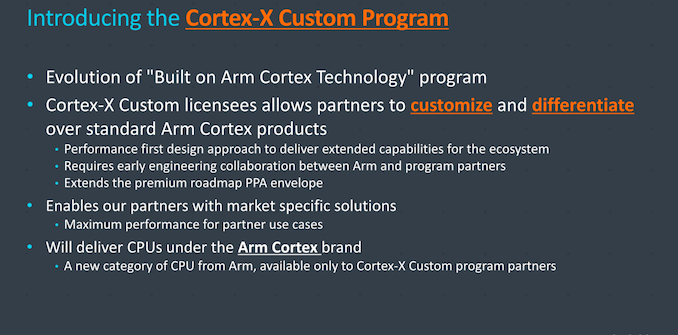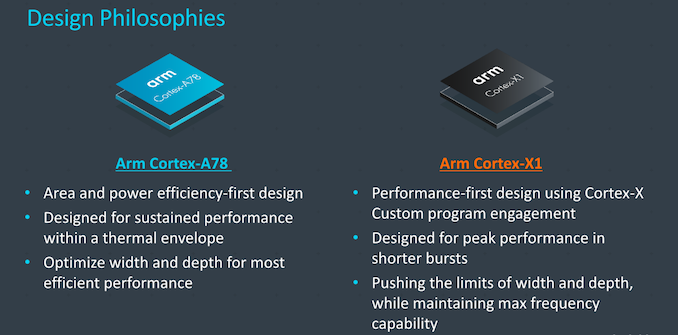Arm's New Cortex-A78 and Cortex-X1 Microarchitectures: An Efficiency and Performance Divergence
by Andrei Frumusanu on May 26, 2020 9:00 AM EST- Posted in
- SoCs
- CPUs
- Arm
- Smartphones
- Mobile
- GPUs
- Cortex
- Cortex A78
- Cortex X1
- Mali G78

2019 was a great year for Arm. On the mobile side of things one could say it was business as usual, as the company continued to see successes with its Cortex cores, particularly the new Cortex-A77 which we’ve now seen employed in flagship chipsets such as the Snapdragon 865. The bigger news for the company over the past year however hasn’t been in the mobile space, but rather in the server space, where one can today rent Neoverse-N1 CPUs such as Amazon’s impressive Graviton2 chip, with more vendors such as Ampere expected to release their server products soon.
While the Arm server space is truly taking off as we speak, aiming to compete against AMD and Intel, Arm hasn't reached the pinnacle of the mobile market – at least, not yet. Arm’s mobile Cortex cores have lived in the shadow of Apple’s custom CPU microarchitectures over the past several years, as Apple has seemingly always managed to beat Cortex designs by significant amounts. While there’s certainly technical reasons to the differences – it was also a lot due to business rationale on Arm’s side.
Today for Arm’s 2020 TechDay announcements, the company is not just releasing a single new CPU microarchitecture, but two. The long-expected Cortex-A78 is indeed finally making an appearance, but Arm is also introducing its new Cortex-X1 CPU as the company’s new flagship performance design. The move is not only surprising, but marks an extremely important divergence in Arm’s business model and design methodology, finally addressing some of the company’s years-long product line compromises.
The New Cortex-A78: Doubling Down on Efficiency
The new Cortex-A78 isn’t exactly a big surprise – Arm had first publicly divulged the Hercules codename over two years ago when they had presented the company’s performance roadmap through 2020. Two years later, and here we are, with the Cortex-A78 representing the third iteration of Arm’s new Austin-family CPU microarchitecture, which had started from scratch with the Cortex-A76.
The new Cortex-A78 pretty much continues Arm’s traditional design philosophy, that being that it’s built with a stringent focus on a balance between performance, power, and area (PPA). PPA is the name of the game for the wider industry, and here Arm is pretty much the leading player on the scene, having been able to provide extremely competitive performance at with low power consumption and small die areas. These design targets are the bread & butter of Arm as the company has an incredible range of customers who aim for very different product use-cases – some favoring performance while some other have cost as their top priority.
All in all (we’ll get into the details later), the Cortex-A78 promises a 20% improvement in sustained performance under an identical power envelope. This figure is meant to be a product performance projection, combining the microarchitecture’s improvements as well as the upcoming 5nm node advancements. The IP should represent a pretty straightforward successor to the already big jump that were the A76 and A77.
The New Cortex-X1: Breaking the Design Constraint Chains
Arm’s existing business model was aimed at trying to create a CPU IP that covers the widest range of customer needs. This creates the problem that you cannot hyper-focus on any one area of the PPA triangle without making compromises in the other two. I mentioned that Arm’s CPU cores have for years lived in the shadow of Apple’s CPU cores, and whilst for sure, the Apple's cores were technical superior, one very large contributing factor in Arm's disadvantage was that the business side of Arm just couldn’t justify building a bigger microarchitecture.
As the company is gaining more customers, and is ramping up R&D resources for designing higher performance cores (with the server space being a big driver), it seems that Arm has finally managed to get to a cross-over point in their design abilities. The company is now able to build and deliver more than a single microarchitecture per year. In a sense, we sort of saw the start of this last year with the introduction of the Neoverse-N1 CPU, already having some more notable microarchitectural changes over its Cortex-A76 mobile sibling.
Taking a quick look at the new Cortex-X1, we find the X1 higher up in Arm’s Greek pantheon family tree of CPU microarchitectures. Codenamed Hera, the design at least is named similarly to its Hercules sibling, denominating their close design relationship. The X1 is much alike the A78 in its fundamental design – in fact both CPUs were created by the same Austin CPU design team in tandem, but with the big difference that the X1 breaks the chains on its power and area constraints, focusing to get the very best performance with very little regard to the other two metrics of the PPA triangle.
The Cortex-X1 was designed within the frame of a new program at Arm, which the company calls the “Cortex-X Custom Program”. The program is an evolution of what the company had previously already done with the “Built on Arm Cortex Technology” program released a few years ago. As a reminder, that license allowed customers to collaborate early in the design phase of a new microarchitecture, and request customizations to the configurations, such as a larger re-order buffer (ROB), differently tuned prefetchers, or interface customizations for better integrations into the SoC designs. Qualcomm was the predominant benefactor of this license, fully taking advantage of the core re-branding options.
The new Cortex-X program is an evolution of the BoACT license, this time around making much more significant microarchitectural changes to the “base” design that is listed on Arm’s product roadmap. Here, Arm proclaims that it allows customers to customize and differentiate their products more; but the real gist of it is that the company now has the resources to finally do what some of its lead customers have been requesting for years.
One thing to note, is that while Arm names the program the “Cortex-X Custom Program”, it’s not to be confused with actual custom microarchitectures by vendors with an architectural license. The custom refers to Arm’s customization of their roadmap CPU cores – the design is still very much built by Arm themselves and they deliver the IP. For now, the X1 IP will also be identical between all licensees, but the company doesn’t rule out vendor-specific changes the future iterations – if there’s interest.
This time around Arm also maintains the marketing and branding over the core, meaning we’ll not be seeing the CPU under different names. All in all, the whole marketing disclosure around the design program is maybe a bit confusing – the simple matter of fact is that the X1 is simply another separate CPU IP offering by Arm, aimed at its leading partners, who are likely willing to pay more for more performance.
At the end of the day, what we're getting are two different microarchitectures – both designed by the same team, and both sharing the same fundamental design blocks – but with the A78 focusing on maximizing the PPA metric and having a big focus on efficiency, while the new Cortex-X1 is able to maximize performance, even if that means compromising on higher power usage or a larger die area.
It’s an incredible design philosophy change for Arm, as the company is no longer handicapped in the ultra-high-tier performance ring with the big players such as Apple, AMD, or Intel – all whilst still retaining their bread & butter design advantages for the more cost-oriented vendors out there who deliver hundreds of millions of devices.
Let’s start by dissecting the microarchitecture changes of the new CPUs, starting off with the Cortex-A78…














192 Comments
View All Comments
Quantumz0d - Tuesday, May 26, 2020 - link
First things first, so what's the cost here of the new X1 vs the 78, we already have $1000 for the smartphone planned obsolescence and now this is next level uber crazy alien tech is going to make them go for obscene $2000 non user replaceable battery junk tech gadgets ?Going wider and 3GHz I don't know maybe maybenot, Zen doesn't clock higher because of it's wider arch from what I saw and the 7N limitations. Even Intel is going wider next, which is going to get hit in the pure clockspeed.
And next, this is hilarious - " they should outright panic at these figures if they actually materialize – and I do expect them to materialize"
Outright panic ? - Let's look at facts 95% Intel, 4.5% AMD from Q4 2019 - Server Marketshare & wonder where does ARM sit here to make both Intel and AMD "Panic".
ARM always about custom this custom that BS, Every single thing needs to be made custom for that crappy ARM part and the LGA socket system is not even a standard for these ARM Server CPUs and x86 is all about the Sockets and in the Consumer space mobile and DIY it doesn't exist, thanks to the Software which is a bigger driving force behind any product in this specturm, esp everyone knows Qualcomm's ever marketed (by Cloudflare) Centriq 2400 10nm Server CPU got deleted from it's existence and even stopped pursuing such goals, where they even put full Kryo SD820's full custom engineers on it and even the guy who was spearheading also moved on.
I will wait to see what's going to happen to the ever bashed x86 by the ARM superiority or the Apple A series Alien processors.
ah06 - Wednesday, May 27, 2020 - link
Those are the facts as of now yes. But the rest of the post sounds like someone about to get disrupted. The bulk of x86 vendor profits come from laptops, specifically general use thin, light and cheap laptops, those are about to be disrupted. Which is to say that in 5 years time, x86 on laptops will cease to exist in any meaningful way. Desktops/Enthusiast parts are not financially relevant to any of these companies.Drake H. - Wednesday, May 27, 2020 - link
Nah. The servers are the pot of gold, where profit margins are really high.You will soon see that ARM will have its small space, but it does not pose a danger to the duopolio x86, something very complex will be coming and everything is already sealed with patents.
Drake H. - Wednesday, May 27, 2020 - link
https://www.phoronix.com/scan.php?page=article&... Here's an example of how ARM outperforms x86. XDYojimbo - Tuesday, May 26, 2020 - link
Hera hated Hercules.vladx - Tuesday, May 26, 2020 - link
We need Zeus next.jaju123 - Tuesday, May 26, 2020 - link
Disappointed that there's no replacement for the ancient a55 yetKamen Rider Blade - Tuesday, May 26, 2020 - link
I concur, A55/A78 still on ARMv8.2-AARM is already on ARMv8.6-A
And there are already announced new CPU instructions coming down the pipe.
https://en.wikipedia.org/wiki/ARM_architecture#Fut...
In May 2019, ARM announced their upcoming Scalable Vector Extension 2 (SVE2) and Transactional Memory Extension (TME).
Raqia - Tuesday, May 26, 2020 - link
It's an interesting drop for this year's ARM tech day: I imagine A78 plans were nebulous when the A76 dropped, and they may have downscaled what is now called the A78 and upscaled what's now the X1. There will likely be a 9cx part for Windows on ARM that can leverage the higher end cores and larger caches very well, but really looking forward to Matterhorn and their new smaller core design which will be very impactful for mobile performance.StormyParis - Tuesday, May 26, 2020 - link
To me, these stories are always kind of exciting and kind of pointless. I'm no longer buying flagships, and even at the low/mid-range, it's been years since I've had, or have heard, a complaint about performance.The apps we use haven't changed in 5 years. Maybe some games, but VR never took off, and InstaGram/Twitter/Maps/FB... are the same. "As long as it has a Core A7x, it is Delightful." Hopefully the X program will help ARM get into consoles, laptops and desktop, and hopefully Android will start supporting that... even today, it's more of an Android problem than an ARM problem. Maybe Windows will fix what Google fumbled.